

Thanks to the digital age in which we now exist, it has become incredibly easy to publish and distribute a press release. Companies can easily send out as many press releases as they want at the press of a button. It is often believed that the more press releases sent out, the better chance a business has to improve its brand image and help drive interest. However, this is not entirely true. Poorly written press releases are unlikely to ever be read in the first place. We’ll go through some essential stages of writing an effective press release and touch on the fundamental principles of what differentiates a press release from any other form of content.
Essentially, they are a one to two-page document that shares breaking news with the public. It is an official statement, that whilst can be valuable to your content marketing strategy, has no intention of selling. Rather, they are sent to targeted members of the media, to pique the interest of a journalist or publication. Typically, they emulate a news article format, using the reverse pyramid structure, to place the most important information first. The goal of a press release is to grab the attention of the media and to propel your brand into the spotlight.
Many companies choose to write and distribute their own press releases for paid or free press release submission sites . Some delegate this task to their PR department and others outsource the creation of their press releases from professional writing services. With so many content providers prowling the content jungle on the web, it should be noted that there are a few select places where you can find quality writers to create the perfect press release for you.
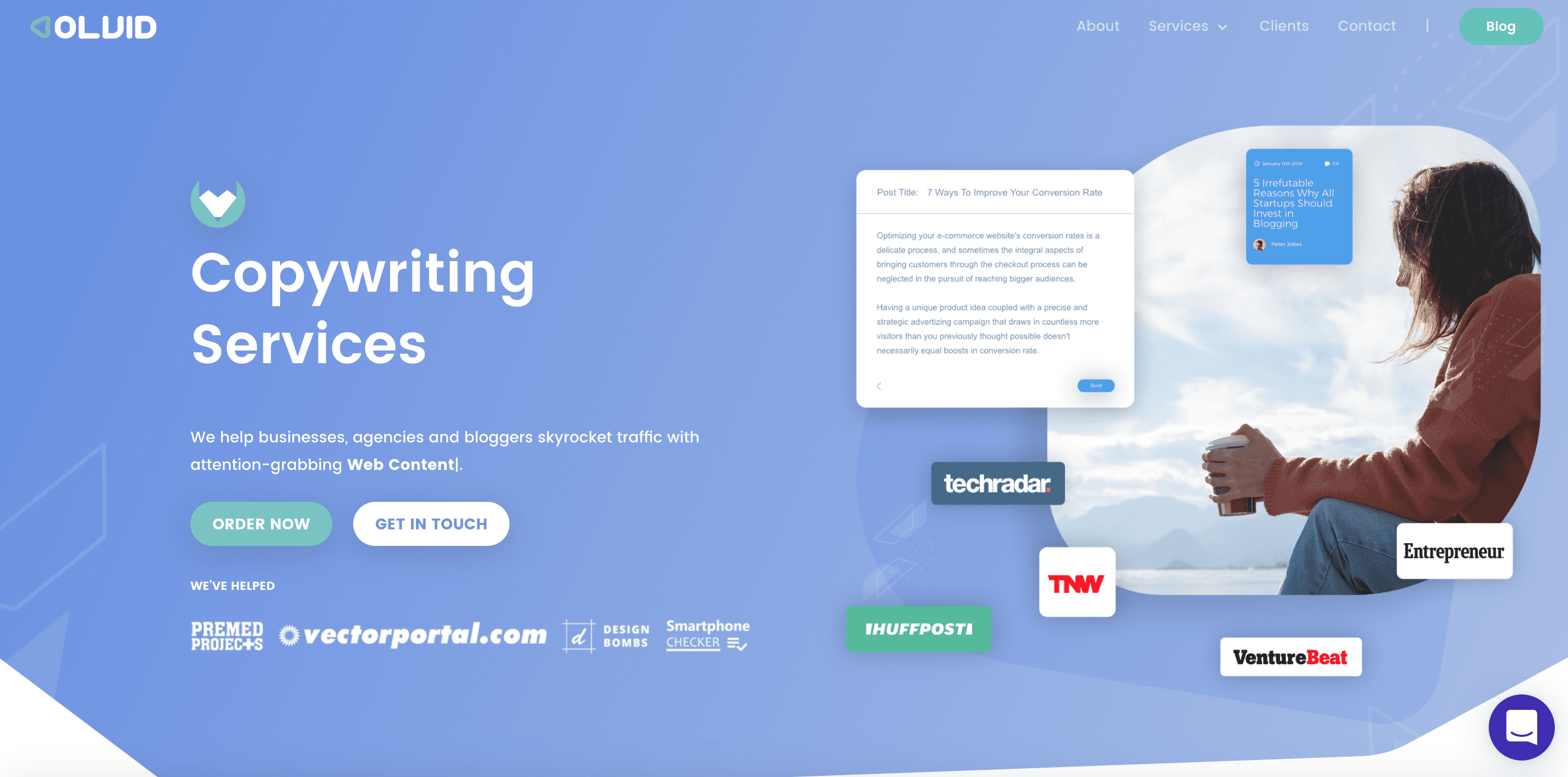
As we now know, practically everyone and their dog possesses the capacity to (on some level) write, publish and distribute a press release. We have also come to understand that there is such a thing as a press release that may never actually reach the press. A few ground rules should be adhered to if you want to avoid wasting your time and effort, and produce a copy that screams press release worth reading.
The first thing to consider is that this official document is to be sent to targeted members of the media. In most cases, this will be journalists. What do journalists like? You guessed it, newsworthy angles. Too often businesses write press releases that are not newsworthy. If the journalist doesn’t pick up on this, it won’t get coverage.
Before you write and issue a press release, ask yourself “is there value in this story? Is there anything new? Anything unusual or unexpected about it? Would it be of interest to anyone outside of my business? Will people care?”
Journalists look for key elements in a press release – primarily human interest. Does your story immediately show that it has an impact on people? By showing this, you can directly and promptly gain the interest of the people your news may impact.
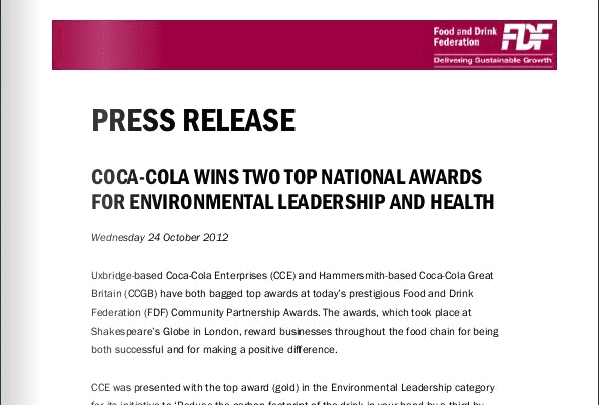
Consider the example above – a Coca-Cola press release that places itself in an incredibly newsworthy angle. Coca-Cola, the company we all know and love and at the same time know isn’t the best choice for our health and environment, has presented itself as a winner of two prestigious awards that go against our very sentiment of the brand. What’s going on here?
Journalists would have raced each other to get their hands on this story, that ultimately emits a whole load of human interest, new and unexpected affairs, and value to everyone.
Like every piece of effective copy, a press release should be written with a target audience in mind. However, a press release shouldn’t be written for that target audience. They are written for the media, be it the editor, journalist or broadcaster and they should be tailored to the readership, viewers and listeners of that publication or programme. Remember, the bulk of each tailored press release might be relatively similar but it is imperative to write a fitting headline and opening paragraph for each media group. For example, press releases sent to the snazzy tech online journal should be tailored differently to those sent to news outlets.
Traditionally, a press release was created primarily for the media to consume and for them to create a story based on your news if they found it to be of relevance and value to their audience. Today, the sands have shifted in the business owners favour and press releases frequently find themselves in close proximity to the immediate target audience of the business. They circulate the web, are posted on company websites and can be easily found by the general public.
Still, it is crucial to bear in mind that while reporters might not be the only ones to access your press release, they remain to be your primary audience. Ultimately, if you don’t pique at the interest of the media, it is likely that few others will be interested either. As per point No.1, the media are interested in exciting, controversial and unexpected news. Simply get this message across to the media and let them get down to the nitty gritty journalistic reporting on your story.
It should be noted that editors of a press release edit from the bottom up. So it is important to ensure the most essential points are at the top. So, what are the essential points?
These answers should all be stated factually in the opening paragraph of a press release. They give the reader an immediate appreciation for what they are about to read and most importantly, determine the level of interest in your news.
The following example of Samsung’s press release hits each nail on the head and does so in an appealing way.
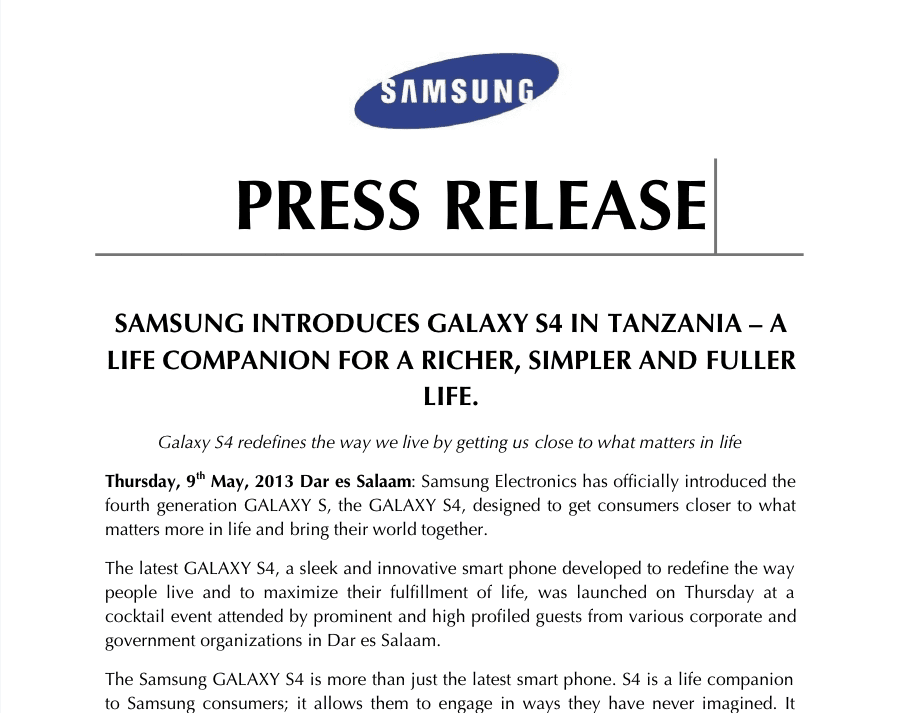
When reading Samsung’s press release, we immediately understand the core issues of the story having read the first snippet. The five W’s gives the reader instant insight into and appreciation for this breaking news. Following this, the reader will expect the next section of the release to provide useful details. This method is a vital component of writing a successful release.
Press releases are formulaic in nature and are created within a particular set of constraints. Like a tweet that presents a particular message within 280 characters, a writer should portray an impressionable message within the confines of a press release. Typically and for the sake and use of journalists who receive many releases; it should take shape in the inverted pyramid structure.
Leading with the most important or most newsworthy information fist, the inverted pyramid places information in order of priority. It minimises fluff and waffle, which means avoiding overuse of adjectives that don’t provide substance. Getting a journalist to open your email is critical and calls for a killer “top line”. This constitutes the utmost important part of your story, which should be placed at the very beginning of your release and should read like the opening of a news story.
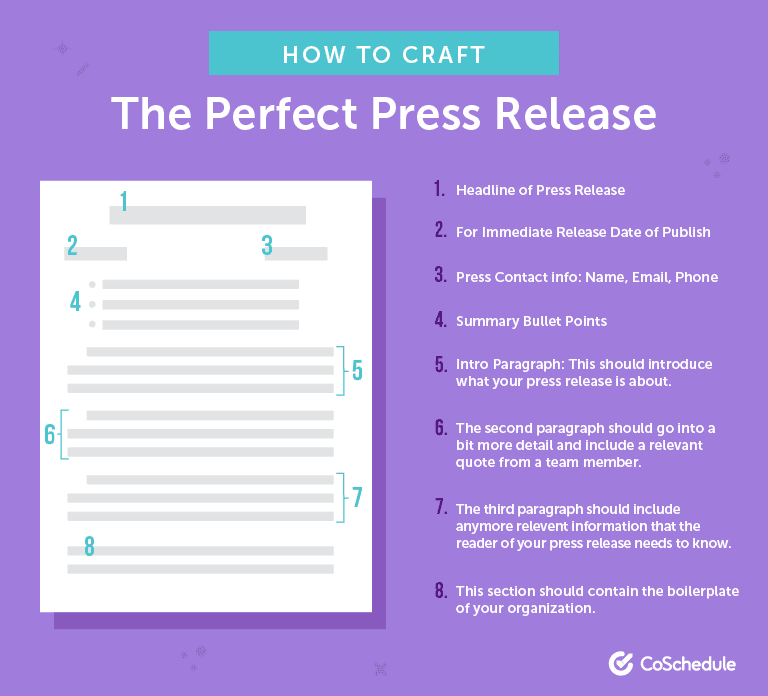
This structure works particularly well given the busy schedule of editors who often have to comb through hundreds of releases each month. The inverted pyramid structure should shape up as follows:
Following this structure should generate a clear and concise release, that is easy to follow and inline with journalistic news principles. It will make your release easy for journalists and editors to navigate and increase your chances of hearing back from them. You can also consider AI-based templates to simplify the process.
As with every piece of copy be it an email, article, newsletter or blog post, the success of your press release depends at least in part (a big part) on its headline. Press release headlines not only tell the reader what the story is about, but they are also your sales pitch to the media. Journalists, editors and broadcasters will use your headline to determine whether the story is even worth reading. If they don’t click with it, they are likely to bin it.
Do not try to be cryptic or clever. Getting the attention of the media is a whole different ballgame from that of your audience. The resulting news story headline should be left to the targeted media’s own writers. Headlines should be clear and simple. If the essence of your story is entertaining and relevant enough, you shouldn’t have to depend on clickbait headlines anyway.
There should be no room for your headline to be misconstrued in any way. Take a look at the following examples for guidance. Note how they each state someone or something doing something worthwhile.
Headlines can make or break any content. To make sure you get it right every time, consider the following tips.
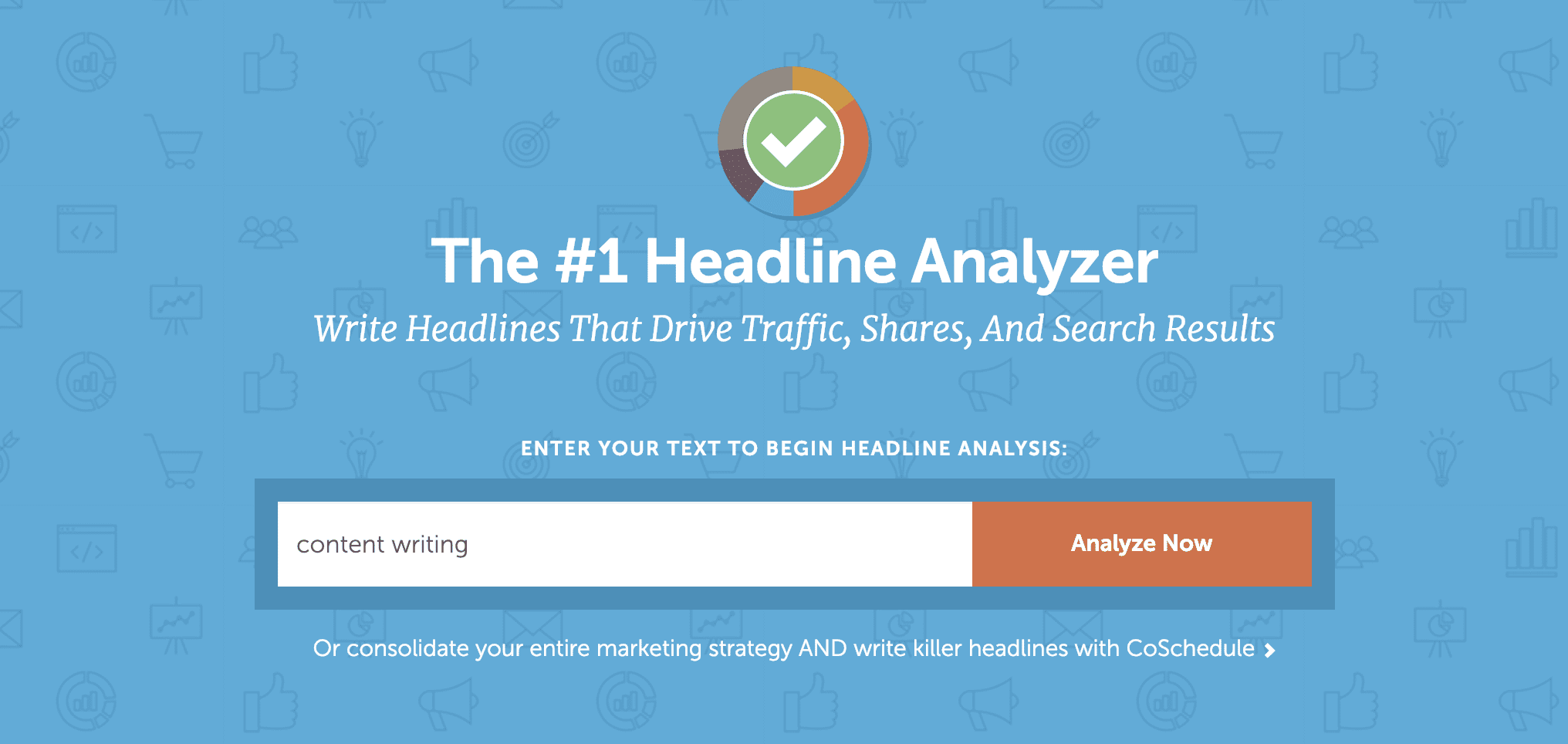
Like a news story, a press release should be written in the third person. The only time it is acceptable to diverge from this golden rule is when you include a quote. Here, it is perfectly fitting to use a first or a second person narrative.
In short, the key thing to remember is to avoid words like “me,” “we,” and “us”. You will find no “we did this” or “I think that” written in the body of a good press release. You should imagine that someone else is telling your story at all times.
One way to get a handle on this style of writing is to pick up any newspaper and see how stories are written. You will notice that each story is in a third person voice, and it is as though the journalist is telling the reader about something or someone else. The trick is to acquire a strict style of writing that is formal, but not too stiff. Keeping it formal and concise will garner respect for readers.
As a clarifying point here, an example would be replacing “I discovered Martians live on Mars” with “It was discovered that there are Martians living on Mars”.
Quotes are an essential part of your press release, do not let them go to waste. At the end of the day, they are the only thing that journalists cannot change so make good use of them by throwing in some strong key messages to strengthen your release.

Quotes should provide insight, not information. Their inclusion is critical to the success of your release. They provide a human angle- precisely what journalists are looking out for when reading your story. This human angle should provide value. For example, if you are trying to circulate a press release to announce a product launch, avoid inserting quotes like “we’re excited to be launching a new product”. This provides no value and negates the benefits of using quotes.
Instead, use a quote that draws upon the bigger picture. For example, Set Enterprise Inc released a new gaming product and used this quote to contextualise their release; “These Mini Rounds help our fans keep their favourite games close so they can play whenever they get an unexpected break; like at a restaurant or in a waiting room.”
The golden rule for using quotes is to provide insight. Do not quote things that fall under the “who, what, when, where and why”. They should be used to bring personal, emotional and human elements to your story. Consider helping the journalist to see the bigger picture by quoting what problems you are trying to solve. Statistics and data can be a helpful way to plump up the strength and credibility of your quote.
“This is a notable milestone to achieve our aspiration of sustainable coffee, served sustainably which is a particular passion for our over 350,000 Starbucks partners.” – John Kelly, Senior Vice President of Global Public Affairs and Social Impact at Starbucks.
“As far back as two years ago, Apache foresaw the potential for gas takeaway constraints in the Permian Basin and initiated two significant mitigating actions…” – John J. Christmann IV, CEO and president of Apache Corporation.
So, you’ve come to the end of your press release and its time to tie it all together. In keeping with the inverted pyramid structure, this is not the time to insert anything of direct importance to your story. It is time to tie it all together.
Additional information
The end of a press release should provide additional relevant links that support it. If your company has more information online that readers may find useful, it should be inserted here. The online nature of the distribution of a press release makes links a handy way to redirect readers to this information.
Contact section
The most important part of the final section of a press release is to ensure you include your contact details in a clear and succinct way. If your story is newsworthy, you can expect journalists to want to get in touch with your company for more information. Make your key people easily contactable by providing contact details on the press release page itself.
Ensure you provide relevant contact details. For example, if your release is on the innovation of your business, you may wish to provide the details of your engineering or research team for the media. It is vital to the success of your press release to include the contact details of the person who will act as the link between the media and your people. Contact details must include:
There you have it, the essential characteristics of an effective press release. Once you have found your newsworthy angle, it is time to begin the writing process. Do not fret at the pressures of writing it yourself as we now know that there are plenty of writing services to do this for you. If you do decide to undertake the creation of your own press release, the next step is to become totally aware of your audience; the media.
Writing for the media is different but no less demanding. Ensure to stick to the inverted pyramid structure and to make good use of the 5 W’s. In doing so, remember to remain in this person at all times, except for the use of quotes. This should remind you nicely of the profound ability of quotes to strengthen your release.
Stick to these ground rules and let the novelty of your released story take care of the rest.